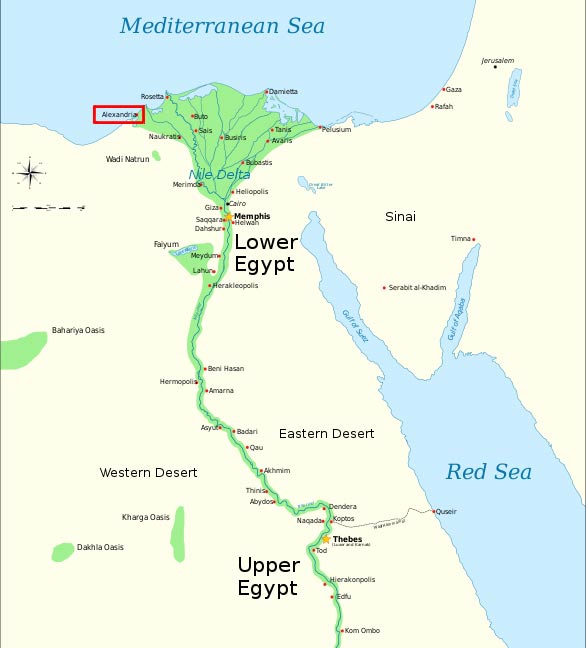Alexandria

Alexandria is a city founded by Alexander the Great in the autumn of 332 BC. It was situated originally on the low tract of land which separate the lake Mareotis from the Mediterranean, about 14 miles west of the Canopic mouth of the Nile. Before the city, in the Mediterranean, lay an island, upon the northeast point of which stood the famous lighthouse, the Pharos, built in the time of Ptolemy I in the 3rd century BC and said to have been 400 feet high. The island was connected with the mainland by a giant causeway (or "mole"), called the Heptastadium, thus forming the two harbors.
The plan of Alexandria was designed by the architect Deinocrates, and its original extent is said to have been about 4 miles in length, with a circumference of 15 miles. It was intersected by two straight main streets, crossing each other at right angles in a large square, and adorned with handsome houses, temples, and public buildings.
The most magnificent quarter of the city was that called the Brucheion, which ran from the center to the eastern harbor. This quarter of the city contained the palaces of the Ptolemies, the Museum, for centuries the focus of intellectual life of the world, and the famous library; the mausoleum of Alexander the Great and of the Ptolemies, the temple of Poseidon, and the great theater. To the south was the beautiful gymnasium. The Serapeum, or temple of Serapis, stood in the western division of the city, which formed the Egyptian quarter, and was called Rhacotis; a small town of that name had occupied the site before the foundation of Alexandria. To the west of the city lay the great Necropolis, and to the east the race-course and suburb of Nicopolis. Much of the space under the houses was occupied by subterranean cisterns, which could hold enough water to supply the whole population of the city for a year.
From the time of its formation, Alexandria was the Greek capital of Egypt. Its population, in the time of its prosperity, is said by Diodorus to have been about 300,000 free citizens, and probably a larger number of slaves. This population consisted mostly of Greeks, Jews, and Egyptians, together with settlers from all nations of the known world. After the death of Alexander the Great, Alexander became the residence of the Ptolemies. They made it, next to Rome and Antioch, the most magnificent city of antiquity, as well as the chief seat of Greek learning and literature, which spread hence over the greater part of the ancient world. The situation of the city, at the junction between the East and West, rendered it the center of the world's commerce, and made it hugely prosperous.
Alexandria had reached its greatest splendor when, on the death of Cleopatra, the last of the Ptolemies, in 30 BC it came into the possession of the Romans. Its glory was long unaffected, and it was the emporium of the world's commerce, especially for corn. In the reign of Caracalla, however, it suffered severely; and the rise of Constantinople promoted the decay of Alexandria. Christianity was introduced, according to tradition, by St Mark. In the 2nd century it had many adherents; among its teachers were Clemens Alexandria and Origen. The struggle between Christian and non-Christian led to bloody strife. The Serapeum, the seat of non-Christian theology and learning, was stormed by Christians in 389 AD, and converted into a Christian church. Alexandria was a chief seat of Christian theology till it was taken by the Arabs, under Amru, in 641, at which time it entered a period of serious decline.
Alexandrian Library
This remarkable collection of books, the largest of the ancient world, was founded by the first Ptolemy (Ptolemy Soter), and fostered by his son. It quickly grew, and already in the time of the first Ptolemy, Demetrius Phalereus, had 50,000 volumes or rolls under his care. During its most flourishing period, under the direction of Zenodotus, Aristarchus of Byzantium, Callimachus, Apollonius Rhodius, and others, it is said to have contained 490,000, or, according to another authority, including all duplicates, as many as 700,000 volumes.
The greater part of this Library, which embraced the collected literature of Rome, Greece, India, and Egypt, was contained in the famous Museum, in the quarter of Alexandria called the Bruchelon. During the siege of Alexandria, by Julius Caesar, this part of the library was destroyed by fire; but it was afterward replaced by the collection of Pergamos, which was presented by Cleopatra to Mark Antony. The other part of the Library was kept in the Serapeum, the temple of Jupiter Serapis, where it remained until the time of Theodosius the Great. When this emperor permitted all the non-Christian temples in the Roman emperor to be destroyed, the magnificent temple of Jupiter Serapis was not spared. A mob of fanatic Christians, led on by the Archbishop Theophilus, stormed and destroyed the temple, together, it is most likely, with the greater part of its literary treasures, in 391 AD. It was at this time that the destruction of the Library was begun and not at the taking of Alexandria by the Arabs, under the Calif Omar, in 641, when its destruction was merely completed.
